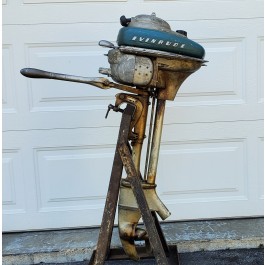|
|
Evinrude Zephyr 4404DescriptionEvinrude Zephyr Model 4404 5.4hp outboard motorClick here for a slideshow of other vehicles in the collection Here's some related history on Evinrude; Here is an interesting writeup on the history of Evinrude and the Outboard Motors Corporation Johnson Four-Stroke IRON HORSE Motors This small four-stroke engine was produced by Johnson Motors starting in 1935. Manufactured in Waukegan, Illinois and Peterborough, Canada, it was a simple engine but rugged & durable enough to run with little attention. The angled cylinder design permitted low-height for engine mounting in close quarter applications and for keeping the center of gravity low. The engine’s adaptability to numerous installations was made possible by a wide variation in equipment - foot-pedal, rope and hand start. During its production cycle, which ended in 1952, there were various models from 1/4hp to 2hp. In addition to powering the Johnson generators, they were also used for washing machines, tillers, water pumps and a host of other power sources on the farm, in garages, workshops and at home. Following the merger with OMC in 1935, the Iron Horse was also used to power the Evinrude Lawn Boy reel-type lawn mower. (Photo in montage) During the 17 years of production there were approximately 250,000 Iron Horse engines made in Canada.  Model 53 Cushman AIRBORNE The Airborne was introduced in 1941: a heavy 255lb. rigid-framed machine with a stock, single-cylinder, 4.5 hp “Husky” 4-stroke motor and non-synchromesh, 2-speed sliding-gear transmission. The vehicle featured a sprung seat and steerable front wheel. The small engine was fitted under the seat with the cylindrical fuel tank aft of the operator. Fenders covered both front and back wheels to protect from dirt spray and other road debris. A skeletal metal framework was set over the engine works of the scooter and a kickstand supported the vehicle when parked. The Airborne’s top speed was 45 mph. The machine was designed to be airdropped by parachute or carried by glider and had a hitch to pull a model M3A4 general-purpose utility cart. The cart could be converted to carry 30-cal or 50-cal. machine guns, or an 81mm mortar. In the later stages of the war in Europe, Allied paratroopers used these scooters to maintain contact between units, increase their mobility and haul small loads. Cushman made nearly 5,000 Airborne scooters for the military. The rugged, simple Model 53 could travel through a foot of water, climb a 25 percent grade and had a range of about 100 miles. After the war, the Airborne was modified with swing-arm rear suspension with sprung trailing link forks, and sold on the civilian market until 1954 as the Model 53-A. Many of them were re-purposed for use by the postal service and police departments after the war. (Cushman became a division of OMC in 1961.) Interesting fact: The 82nd Airborne used many of these in France after D-Day.  Here is a picture of a 1957 Evinrude Flying Saucer fishing boat  1970 Evinrude Lakester Prototype.  Here is the Boeing Model 540 Gas Turbine Outboard Motor. In mid 1959, Boeing prepared layout designs of several alternative outboard gas turbine engines for marine use, with the U.S. Navy’s needs particularly in mind. In mid 1960, a go-ahead was made to build a demonstrator, making use of some existing test-rig components that had been designed to evaluate improved small-engine technologies. The goal was a 100-shp free turbine outboard engine delivering 1.0 lb/hp/hr sfc, using commercial off-the-shelf components as much as possible. The demonstrator was mounted on a Mercury Model 800 outboard propeller drive unit. The demonstrator was running in a 20-ft boat by the fall of 1961, and a proposal to the Navy was made in March 1962. The engine featured a monorotor gas generator (centrifugal compressor and radial-inflow turbine) and an axial power turbine. In the demonstrator, a radial turbine was used for the power turbine, and all rotors were hogged out of forgings; but they were to be cast in the production engine. Most of the controls and accessories were off-the-shelf items. A single reverse-flow thumb-type (stickeing out radially) combustor was used. A single-stage offset layshaft gear set provided 5.82:1 reduction. Early in its testing, the engine delivered its output goals. Boeing expected to easily grow the engine to 150 shp with 0.88 lb/shp/hr sfc at 1,775°F turbine inlet temperature. Production engine weight was estimated to be 180 lb, development engines were expected to weigh 210 lb, and the demonstrator weighed a few pounds more than that. The Navy wanted a commercially available engine, and Boeing had discussions with a prominent outboard engine manufacturer, which expressed interest. However, Boeing would not commit to marketing a commercial engine, and the Navy did not accept the proposal. The Boeing engineers on the program were extremely disappointed; the demonstrator was shelved in 1962. So ended the Model 540, a beautiful and simple engine that would have revolutionized the boat engine market. Boeing had done its homework, and was envisioning using the 540 basic engine for auxiliary power unit, pumping, generating, etc., but there was no follow-through.  Equipment Specifications
Detailed Information
|













